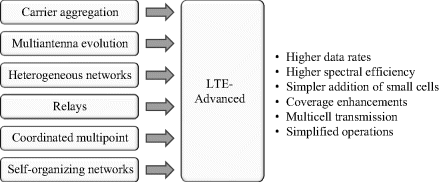1.7 LTE-Advanced Overview
The main features of LTE-Advanced are summarized in Figure 1.8.
Figure 1.8 Overview of LTE-Advanced main features.

- Downlink carrier aggregation to push the data rate initially to 300 Mbps with 20 + 20 MHz spectrum and 2 × 2 MIMO, and later to even 3 Gbps by using 100 MHz bandwidth and 8 × 8 MIMO. More bandwidth is the handy solution to increase the data rates.
- Multiantenna MIMO evolution to 8 × 8 in downlink and 4 × 4 in uplink. The multiantenna MIMO can also be used at the base station while keeping the number of terminal antennas low. This approach offers the beamforming benefits increasing the network capacity while keeping the terminal complexity low. Multiantennas increase the data rates and the network capacity.
- Heterogeneous network (HetNet) for the co-channel deployment of macrocells and small cells. HetNet features enable interference coordination between the cell layers. Those features enhance the network capacity and coverage with high density of small cells while sharing the frequency with large macrocells.
- Relay nodes for backhauling the base stations via LTE radio interface. The transmission link can use inband or outband transmission. Relays are practical for increasing network coverage if the backhaul connections are not available.
- Coordinated multipoint transmission and reception allows using several cells for the data connection towards ...
Get LTE Advanced: 3GPP Solution for IMT-Advanced now with the O’Reilly learning platform.
O’Reilly members experience books, live events, courses curated by job role, and more from O’Reilly and nearly 200 top publishers.

